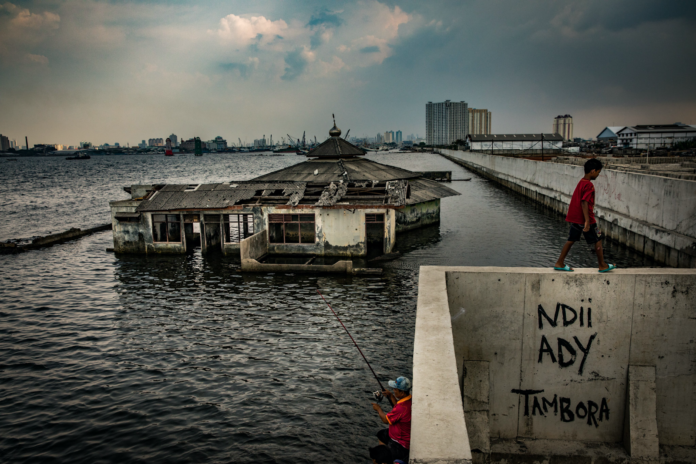Source: The New York Times https://www.nytimes.com/interactive/2017/12/21/world/asia/jakarta-sinking-climate.html
By Josh Daniels
The 17,508 islands that make up Indonesia span over 5,000 kilometers long and are home to over 270 million individuals. Over half of these people live on Java, the island where the nation’s capital, Jakarta, is located. Sadly, the once prosperous city has been in crisis for a rather unusual reason. The capital has been struggling to stay above water, and flooding and infrastructure problems have caused turmoil in the city. The coastal city is predicted to be underwater by 2050, but ironically, the people of Jakarta don’t have enough water and its causing the city to sink.
It sounds confusing, but to understand what is happening in the capital, you have to travel back through time to the 1600’s. During this time of world colonization by European powers, the Dutch took control of what would become Jakarta, naming it Batavia. The city was built similarly to Amsterdam, with canals that created neighborhoods and ran through the town for trading purposes. The 13 rivers flowing through Batavia helped with making the canals. However, these canals were exactly what caused the lack of water to residents of Jakarta today.
The canals were used for drinking water, trading, transportation, and more, but they all served one more common purpose: segregation. As the dutch were outnumbered by the natives, they did not want all of them to be living in the same connected areas. The canals split the cities into neighborhoods, where people of similar ethnicities were placed. However, when the dutch did not maintain the canals, they became home to disease. Jakarta’s waters spread disease throughout the city rapidly, and the Dutch moved further south of the city. They built pipes from another water source, giving them clean water for bathing and drinking. The issue was the pipes only reached to European communities in the city, and the name ‘Kampong’ was given to the non-european areas in which clean water was not available. When the Dutch recognized Indonesia as independent in 1904, Jakarta built wells in Kampongs that connected to aquifers, fresh water sources deep below the ground in spaces in between rocks. The access to clean water gave birth to a beautiful city to live in, and the population skyrocketed throughout the next century.
Aquifer’s waters are typically replenished everytime it rains, as water soaks into the ground and falls into these underground water deposits. However, as the population increased, the city became more advanced. Concrete began to be used throughout the capital, slowly starting the downfall of Jakarta. With concrete covering the land, rainfall could not replenish the aquifers. As more wells were built in neighborhoods, the water supply in aquifers decreased. Think of the aquifers as a sponge. When the water is extracted, the spaces between the rocks are no longer filled, and the rock deflates. If the water keeps being taken and cannot be replenished, the soil above the aquifers starts to collapse. This is causing the city to sink.
Many have had to rebuild their homes several times, as the land is sinking at a rate of 10 inches per year currently. Certain areas have sunk by 4 meters in the last 50 years, and devastating floods, such as the floods in 2007, have killed many Jakartans and left even more without a home. Still, no water source has been provided outside of the wells, which could completely save Jakarta. Tokyo, Taipei, Shanghai, and Bangkok have all had similar problems, where overused wells have caused sinking, but they solved the issue by creating an alternative water source, like pipes. Indonesia has not done so, and instead wants to shift the capital from Jakarta to Borneo. The media in Indonesia has not been speaking out the real reason behind the disaster, and have come up with different, ineffective alternatives to stop flooding. Seawalls in order to prevent the floods are being built, but they have not and will not work, as they continue to sink with the land around it. Thousands of people are and will continue to be at risk inside the borders of Jakarta.

